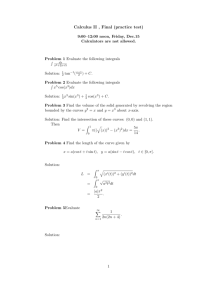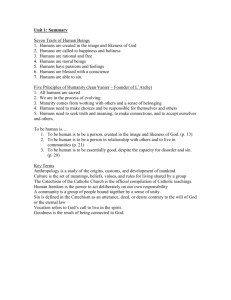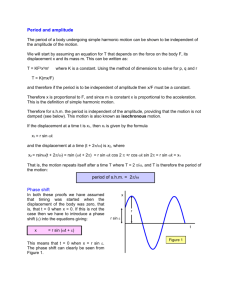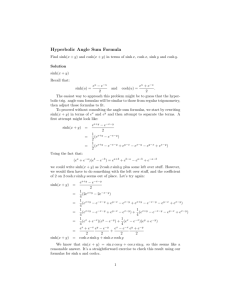MANE6630_CHT_HW03_WBraz
advertisement
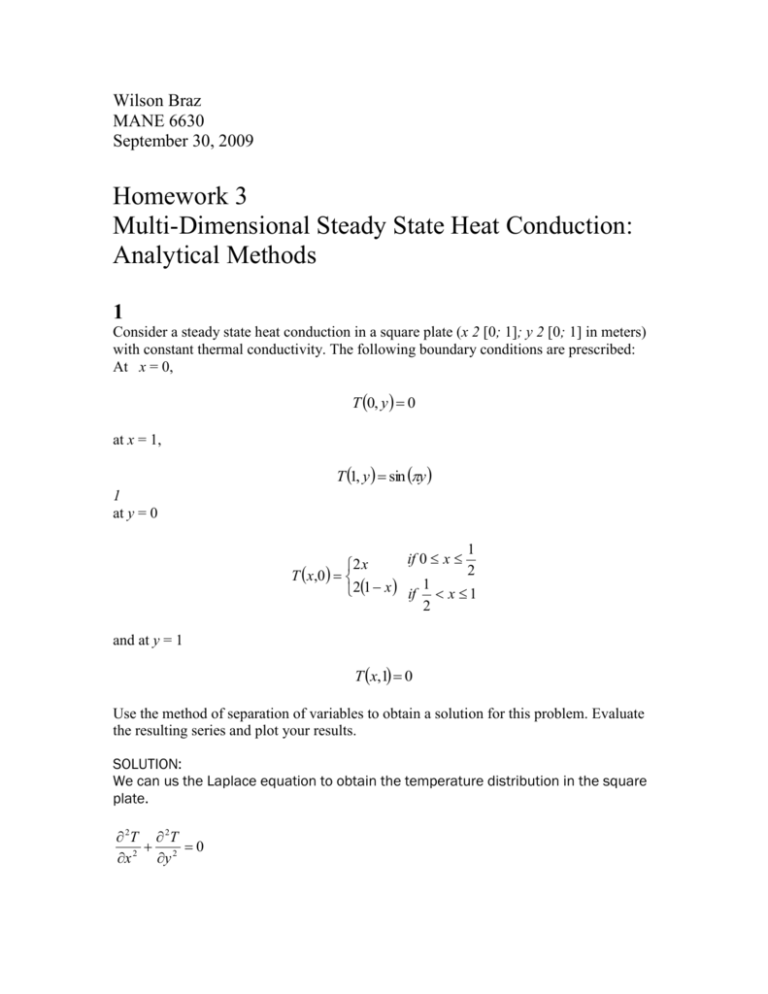
Wilson Braz MANE 6630 September 30, 2009 Homework 3 Multi-Dimensional Steady State Heat Conduction: Analytical Methods 1 Consider a steady state heat conduction in a square plate (x 2 [0; 1]; y 2 [0; 1] in meters) with constant thermal conductivity. The following boundary conditions are prescribed: At x = 0, T 0, y 0 at x = 1, T 1, y sin y 1 at y = 0 1 if 0 x 2 x 2 T x,0 1 2 1 x if x 1 2 and at y = 1 T x,1 0 Use the method of separation of variables to obtain a solution for this problem. Evaluate the resulting series and plot your results. SOLUTION: We can us the Laplace equation to obtain the temperature distribution in the square plate. 2T 2T 0 x 2 y 2 This problem contains non-homogeneous boundary conditions. Since the Laplace equation is linear, we can use the principal of superposition to obtain a solution to the problem. T x, y T1 x, y T2 x, y Using the method of separation of variables: T1 x, y X x Y y Substitute into Laplace equation: 2 X 2Y Y 2 X 2 0 x y ---------------------------1 2 X 1 2Y X x 2 Y y 2 ---------------------------Introduce the separation constant . 2 X X x 0 x 2 2Y Y y 0 y 2 ---------------------------Let: 2 The solution to the above equations become: X x Asin x B cos x and Y x C sinh y D cosh y ---------------------------Applying the boundary conditions to the general rectangular element yields: nx X n x An sin W ny Yn x Bn sin H Where H is the height in the y direction and W is the width in the x direction. The solution is the linear combination of all eigenfunctions. T x, y Tn x, y X n x Yn y n 1 T x, y C n sin n 1 nx ny sinh W H Next, we apply the general solution and the principal of superposition to the problem given: T1 x, y C n sinh nx sin ny n 1 Where 1 cn1 T 1, y sin ny dy 0 1 sinh n sin ny dy 1 2 sin y sin ny dy 0 1 sinh n sin ny dy . 2 0 0 Since the given boundary condition is sin y , the only the first Fourier coefficient is non-zero, therefore T1 becomes: T1 x, y C1 sinh x sin y T2 is given as: T2 x, y C n sin nx sinh n 1 y n 1 Where 1 C n2 T x,0sin nx dx 0 1 sinh n sin nx dx 2 0 0.5 1 2 x sin nx dx 0 0.5 sinh n sin nx dx 2 0 21 x sin nx dx 0.5 1 sinh n sin nx dx 2 0.5 The following graphic was created by inputting the previous equation into and plotting on a 3D plot in MAPLE: 2 The temperature inside a circular cylinder (radius = 1, height = 1, in meters) is independent of the angular coordinate (axisymmetric system). The following boundary conditions are prescribed: At z = 0 T (r, 0) = 0 At z = 1 T (r, 1) = (1 - r)3 At its side surface, r = 1 T (1, z) = 0 Also, note that because of symmetry, the temperature has an extremum at r = 0. Use the method of separation of variables to obtain a solution for this problem. Evaluate the resulting series and plot your results. SOLUTION: The governing heat equation for the problem given is as follows: 2T 0 1 2T 0 r r r r z 2 ---------------------------Let: T r, z Rr Z z T RZ R Z ZR' r r r 2T 2 RZ Z ZR' ' r 2 r 2 2T RZ ' ' z 2 ---------------------------1 ZR' ZR' ' RZ ' ' 0 r 1 R' R' ' Z '' 2 r R R Z r R' 2 R' ' Z '' r r 2 2 R R Z Using separation of variables: r 2 R' 'rR' 2 r 2 R 0 R A1 J 0 n r A2Y0 n r (Bessel equation) Z ' ' 2 Z 0 Z B1 sinh 1 z B2 coshz After applying the prescribed boundary conditions, A2 and B2 = 0. The temperature distribution becomes: T r , z C n J 0 n z sinh n z n 1 where: 1 r 1 r J r dr 3 0 Cn n 0 sinh n r J 0 n r dr 2 and n are the eigenvalues of J 0 n 0 . 3 Consider the problem of steady state heat conduction inside a cylinder (radius = 0.1, height = 1, in meters), of constant thermal conductivity k = 1 W/mK and subjected to a process of constant internal heat generation at a rate of g = 105 W/m3. Assume all the external surfaces of the cylinder are maintained at zero temperature. Use the method of separation of variables to obtain a solution for this problem. Evaluate the resulting series and plot your results. SOLUTION: The governing heat equation for the problem given is as follows: k 2T g 0 1 2T g r 2 r r r z k Boundary conditions: a bcdef ghi j klmnopq rs t uv wx yz ABCDEFGHIJKLMNOPQRSTUVWXYZ
